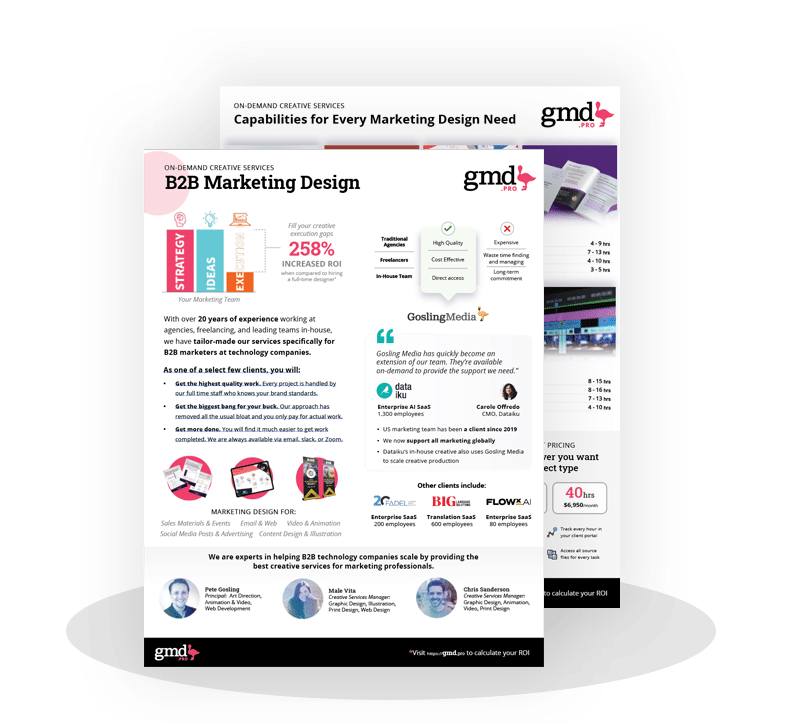In B2B marketing design, the focus is on business objectives, lead generation, and professional decision-makers, while general graphic design prioritizes visual appeal and emotional connections for the general public. B2B design tackles complex decision-making processes involving 6–10 stakeholders, requiring clear, data-driven, and professional content. In contrast, general design emphasizes creative, versatile visuals for quick consumer engagement.
Quick Comparison
| Aspect | B2B Marketing Design | General Graphic Design |
|---|---|---|
| Primary Focus | Business goals & lead generation | Visual communication & aesthetics |
| Target Audience | Professional decision-makers | General public or consumer segments |
| Decision Process | Complex (6–10 stakeholders) | Simple (individual or small groups) |
| Content Style | Professional, data-driven, detailed | Creative, emotion-driven, versatile |
| Sales Cycle | Long-term relationship building | Quick conversions |
B2B design is about results, trust, and clarity, while general design is about creativity and emotional appeal. Both have unique strengths but serve different purposes.
What Is The Difference Between B2B And B2C Branding …
1. B2B Design Requirements
B2B marketing design requires a focused approach to address the complexities of business-to-business interactions.
Understanding the Target Audience
B2B designs cater to a wide range of stakeholders. In fact, 77% of B2B customers describe their purchasing process as "very complex or difficult", which means messaging needs to be tailored for different roles. Typically, 6–10 decision-makers are involved in a B2B purchase, and each one needs specific information and reassurance.
| Stakeholder Type | Design Focus | Content Needs |
|---|---|---|
| Decision Makers | ROI metrics & business impact | Executive summaries, cost analysis |
| Technical Users | Product specifications | Detailed documentation, integration guides |
| Influencers | Industry trends & insights | Thought leadership content, case studies |
| Gatekeepers | Compliance & security | Technical specifications, certification details |
Visual Style Matters
Visuals play a critical role in B2B marketing. Professional audiences process visuals up to 60,000 times faster than text. To make an impact, designs should focus on:
-
Professional Presentation
Clean, uncluttered layouts that highlight key data and solutions. Executives are 65% more likely to retain information when paired with relevant visuals. -
Consistency Across the Brand
Uniform design elements across platforms foster trust and recognition. As Social Media Manager Rami Zaki explains: "Ensuring brand image consistency is much more difficult than just managing the logo placement". -
Content-Driven Design
Since 72% of B2B buyers engage with at least three pieces of content before making a purchase, design must enhance content readability while maintaining a polished, professional look.
These principles ensure that visuals effectively support business objectives.
Aligning Design with Business Goals
For B2B design to be effective, it must align with key business goals by presenting data in a format that busy executives can quickly understand.
Key metrics highlight the importance of this alignment:
- 74% of B2B sales to new customers take at least 4 months to finalize.
- Companies with a structured sales process see 28% higher revenue growth.
- Well-qualified leads boost conversion rates by 72%.
Strategic visual design, combined with a strong focus on content, plays a vital role in achieving these outcomes.
Content That Drives Results
B2B design also needs to support the longer sales cycles and complex decision-making processes typical in this space. To do this, it should include:
- Clear technical details for decision-makers
- Data visualizations that simplify complex ideas
- Case studies and evidence to build trust
- Tools that help stakeholders share information
- Features that nurture leads throughout the sales funnel
Companies that use well-designed content to nurture leads generate 50% more sales-ready leads while reducing costs by 33%. This underscores how effective B2B design can directly influence business success.
2. General Design Elements
General graphic design takes a broad approach, focusing on visual appeal rather than the targeted strategies seen in B2B design. Instead of honing in on specific audiences, it aims to attract a wide range of viewers with engaging visuals.
Target Audience Considerations
While B2B design emphasizes nurturing long-term leads, general design prioritizes creating an immediate visual impact. Its goal is to connect with a diverse audience, requiring visuals that are both clear and broadly appealing.
"Good design is about how something works, not about how it looks or feels".
The influence of audience targeting is clear:
- Users form an opinion about a website in just 50 milliseconds.
- A delay of four to five seconds in website loading time causes 20% of viewers to leave.
- Better audience targeting often results in higher conversion rates.
Visual Style Priorities
General design places a strong emphasis on aesthetics, which is reflected in several areas:
| Design Element | Focus | Impact |
|---|---|---|
| Aesthetics | Visual appeal and creativity | Grabs attention instantly |
| Typography | Style and personality | Builds brand identity |
| Color Usage | Emotional response | Connects with customers |
| Layout | Visual hierarchy | Ensures smooth information flow |
These elements are designed to create visuals that not only look appealing but also engage viewers quickly.
Content Approach
The content strategy for general design focuses on three main priorities:
-
Capture attention instantly
Visuals are crafted to grab attention right away, emphasizing style over detailed explanations. This approach aligns with the fast decision-making seen in consumer markets. -
Accessibility
Designs aim to appeal to a wide audience, avoiding overly technical or niche elements.
"The idea isn’t to draw the most traffic; it’s, it’s to draw the right traffic".
- Emotional Connection
Visuals are tailored to create an emotional bond, engaging viewers on a more instinctive level.
This approach ensures that the design resonates with audiences while supporting broader business objectives.
Business Goals Alignment
General graphic design also plays a role in meeting business goals. For example, 71% of B2B marketers reported that content marketing became more important in 2023. Other key statistics include:
- 65% of customers watch videos more than once daily.
- 84% of buyers use online review sites when evaluating purchases.
- 81% of buyers consider easy access to pricing information crucial.
These numbers highlight the need for designs that balance visual appeal with functionality, ensuring they contribute to measurable business outcomes.
sbb-itb-3ff8c64
Strengths and Limitations
B2B marketing design and general graphic design each come with unique benefits and challenges that shape how strategies are developed.
Core Strengths
Humans can process visual information in just 13 milliseconds. This makes it crucial for B2B materials to effectively communicate complex, technical content quickly. These designs prioritize functionality and business impact, aligning with the priorities of corporate decision-makers who often need to justify purchases to multiple stakeholders.
A standout advantage of B2B design is its ability to nurture long-term relationships. Clear and professional designs help guide buyers through complex purchasing journeys and influence 56% of final purchase decisions.
"Companies that don’t understand Design don’t invest enough in it. This cripples Design, furthering the bias that designers are less capable than other functions. This fuels further lack of investment. The cycle repeats from there." – Ryan Scott, Founder, Leading Design Co.
Comparative Analysis
The table below highlights the differences between B2B marketing design and general graphic design:
| Aspect | B2B Marketing Design | General Graphic Design |
|---|---|---|
| Decision Process | Involves 6–10 decision-makers | Targets individual consumers |
| Content Depth | Detailed technical information | Appeals to emotions broadly |
| Design Style | Conservative and professional | Bold and experimental |
| ROI Focus | Stresses business value | Focuses on personal benefits |
| Sales Cycle | Builds long-term relationships | Aims for quick conversions |
| Brand Building | Requires 5–7 interactions | Creates immediate impact |
Key Limitations
B2B design often grapples with lengthy approval processes due to the involvement of multiple stakeholders. These extended cycles demand detailed documentation and can slow progress.
Another challenge lies in industry practices. While 75% of B2B buyers seek useful branded content, 93% of brands still focus on promoting their own products instead.
Additionally, measuring the impact of design remains a hurdle. Only 54% of B2B businesses actively track brand perceptions, making it tough to evaluate design effectiveness or justify further investment in creative efforts.
Strategic Advantages
B2B email marketing offers impressive returns, generating $36 for every $1 spent. Thoughtful use of color can also increase brand recognition by 80%. Moreover, brands that are familiar to decision-makers before the buying process begins are more than twice as likely to succeed.
Customer experience also plays a major role. Among top-performing B2B companies, 80% credit their customer experience strategies with boosting customer lifetime value. Smart design is a key part of creating these meaningful interactions.
These insights highlight areas where B2B marketing design can deliver measurable results and improve overall effectiveness.
Next Steps
To make the most of B2B marketing design, you’ll need focused strategies that turn ideas into action.
Set Clear Design Objectives
Start by defining measurable goals that align with lead generation, conversion rates, and brand awareness. Research shows that businesses using a systematic approach to goal-setting can grow 3–10 times faster and double their profitability.
Track Performance Effectively
After setting goals, it’s crucial to monitor progress. Use analytics tools to measure design performance across different channels. Here are key metrics to focus on:
| Metric Category | Key Performance Indicators | Industry Benchmark |
|---|---|---|
| Content Engagement | Email engagement | 71% of B2B firms track this |
| Lead Generation | Website conversion rate | 73% measure consistently |
| Brand Impact | Social media reach | 65% monitor regularly |
| Sales Enablement | Proposal close rate | 10% higher with automation |
Address Long Sales Cycles
The average B2B sales cycle now spans 379 days, a 16% increase since 2021. To navigate these extended timelines, provide educational content that builds trust and keeps your branding consistent.
"Brand building is about creating lasting impressions in people’s minds that predispose them to choose your brand in the future."
– Binet & Field, Media in Focus
Strengthen Your Digital Presence
With 80% of potential clients researching providers through websites, ensure your site stands out. Focus on professional design, easy navigation, clear value propositions, and content that addresses key customer challenges.
Simplify Design Processes
Improve efficiency by integrating proposal automation and CRM tools. Automated reminders can boost proposal close rates by 10%, yet only 7% of sellers currently use this feature.
Invest in Team Development
Keep up with the latest B2B design trends and tools. As Jonathan Franchell, CEO of Ironpaper, puts it: "Effective content in the awareness phase educates the buyer on their pain points". Equip your team with both creative expertise and a deep understanding of the B2B market.
FAQs
What makes B2B marketing design different from general graphic design in terms of audience and goals?
B2B marketing design is tailored to professional audiences, such as businesses and corporate decision-makers, whereas general graphic design typically targets individual consumers. This distinction influences the tone, style, and purpose of the design.
In B2B marketing, the focus is on communicating value, functionality, and ROI, often addressing complex business needs and longer decision-making processes. On the other hand, general graphic design emphasizes personal appeal and emotional connections, often showcasing lifestyle benefits or immediate satisfaction. B2B design prioritizes clarity and strategy, aligning with business objectives, while general graphic design leans more on creativity and broad consumer appeal.
How does B2B marketing design address long sales cycles and complex decision-making?
B2B marketing design plays a crucial role in supporting long sales cycles and complex decision-making by prioritizing clarity, trust, and engagement. It provides detailed product or service information, such as technical specifications, pricing, and customization options, to help businesses make informed decisions. A strong value proposition that highlights unique benefits is essential to capturing attention and building interest.
Trust is established through case studies, testimonials, and success stories, which demonstrate credibility and reliability. Additionally, offering tailored content, such as role-specific resources or interactive proposals, ensures that multiple stakeholders are engaged effectively throughout the decision-making process. By nurturing leads with personalized communication and streamlining access to key information, B2B marketing design helps drive conversions in professional markets.
How can businesses ensure their B2B marketing design stays consistent and effective across different platforms?
To maintain consistency and effectiveness in B2B marketing design across platforms, start by creating a comprehensive visual design system that includes guidelines for colors, typography, imagery, and other elements. This ensures a unified look and feel across all materials.
Regularly update and document your design components to keep everyone on the same page. Encourage collaboration between teams to align messaging and visuals, and conduct usability testing to identify and fix inconsistencies. Finally, onboarding new team members with clear processes ensures long-term adherence to your design standards.







